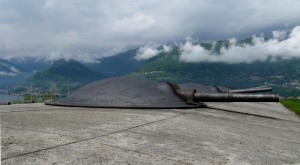 Today being grey and overcast, we visited two historic, strategically located defensive points at the northern end of the Lago di Como. The first, il Forte di Fuentes, was built in 1603 by a Milan-based Spanish Duke and mostly destroyed in 1796 by Napoleon as a peaceful gesture to the Grissons. The second, the First World War Forte Montecchio, is located on a hill just alongside the first. Both stand at the mouth of the Adda, the main river feeding the Lago di Como, and overlook two valleys, the Valtellina and the Valchiavenna, and both were built in anticipation of invading forces descending down either valley towards the Po Plain. However, uulike Fuentes, the Forte Montecchio is largely intact. Indeed, a stupendous example of Italian military architecture, it is the best preserved fort of its kind still standing in Italy. It probably owes this to the facts that, though a key structure in the ‘Cadorna line’, it never saw true action but was nevertheless maintained in some sort of military usage until 1981. Now, a jovial and erudite guide shows visitors around the Fort. It was built in one year and was obsolete by the end of the next. This was because it was built with massive walls to withstand cannon attacks but with relatively thin roofs that would not have been able to withstand attacks from Austrian howitzers and mortars. In any case, the expected Austro-Hungarian invasion never came. Interestingly, the Fort’s four cannons (perfectly preserved to this day) were designed primarily not to fire on any advancing force but, rather, to destroy bridges, railway lines and canals – a case of deliberate friendly fire. The place is wonderfully atmospheric – down to stencilled Mussolini-era mottos (‘courage is a habit!’) – and would surely be a great film set. A small but well-illustrated guide, by Stefano Cassinelli, is available from Guide Macchione, for ‘White War’ enthusiasts and is well worth its cover price.
Today being grey and overcast, we visited two historic, strategically located defensive points at the northern end of the Lago di Como. The first, il Forte di Fuentes, was built in 1603 by a Milan-based Spanish Duke and mostly destroyed in 1796 by Napoleon as a peaceful gesture to the Grissons. The second, the First World War Forte Montecchio, is located on a hill just alongside the first. Both stand at the mouth of the Adda, the main river feeding the Lago di Como, and overlook two valleys, the Valtellina and the Valchiavenna, and both were built in anticipation of invading forces descending down either valley towards the Po Plain. However, uulike Fuentes, the Forte Montecchio is largely intact. Indeed, a stupendous example of Italian military architecture, it is the best preserved fort of its kind still standing in Italy. It probably owes this to the facts that, though a key structure in the ‘Cadorna line’, it never saw true action but was nevertheless maintained in some sort of military usage until 1981. Now, a jovial and erudite guide shows visitors around the Fort. It was built in one year and was obsolete by the end of the next. This was because it was built with massive walls to withstand cannon attacks but with relatively thin roofs that would not have been able to withstand attacks from Austrian howitzers and mortars. In any case, the expected Austro-Hungarian invasion never came. Interestingly, the Fort’s four cannons (perfectly preserved to this day) were designed primarily not to fire on any advancing force but, rather, to destroy bridges, railway lines and canals – a case of deliberate friendly fire. The place is wonderfully atmospheric – down to stencilled Mussolini-era mottos (‘courage is a habit!’) – and would surely be a great film set. A small but well-illustrated guide, by Stefano Cassinelli, is available from Guide Macchione, for ‘White War’ enthusiasts and is well worth its cover price.
0 Comments
1 Pingback